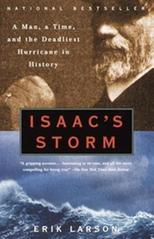 On September 8, 1900, a Category 4 hurricane made landfall in Galveston, Texas. The city, on an island just eight feet above sea level, was hit by a 15-foot storm surge. Some 3,600 homes were destroyed and 6,000 to 12,000 lives were lost, making it the deadliest natural disaster in U.S. history. Galveston never fully recovered. Even though the island was raised by 17 feet and a 10-mile-long seawall was constructed, the hurricane caused wary investors to shift their assets to nearby Houston, making it the dominant Texas port city.
On September 8, 1900, a Category 4 hurricane made landfall in Galveston, Texas. The city, on an island just eight feet above sea level, was hit by a 15-foot storm surge. Some 3,600 homes were destroyed and 6,000 to 12,000 lives were lost, making it the deadliest natural disaster in U.S. history. Galveston never fully recovered. Even though the island was raised by 17 feet and a 10-mile-long seawall was constructed, the hurricane caused wary investors to shift their assets to nearby Houston, making it the dominant Texas port city.
The lack of swift communication and reliable remote observation made turn-of-the-century meteorology uncertain at best. Despite reports from Cuba that a severe storm was heading toward Texas, the U.S. Weather Bureau predicted it would impact Florida. The residents of Galveston were generally unconcerned until the night of September 7, when Isaac Cline, the chief meteorologist in the city's Weather Bureau office, unilaterally (and against protocol) issued a hurricane warning--too late for anyone to evacuate. Cline's pregnant wife drowned when their house was destroyed by the storm surge.
Isaac's Storm: A Man, a Time, and the Deadliest Hurricane in History by Erik Larson (1999) chronicles the circumstances of Galveston's rise to prominence, its destruction and the aftermath, with Isaac Cline in the eye of the storm--including the meteorologist's infamous 1891 article in the Galveston Daily News, in which Cline claimed a significant hurricane strike on Galveston was a "crazy idea." Thanks in part to Cline's professional recommendation, the city decided not to build a seawall at the time. --Tobias Mutter

